belt HYUNDAI I10 2011 Owners Manual
[x] Cancel search | Manufacturer: HYUNDAI, Model Year: 2011, Model line: I10, Model: HYUNDAI I10 2011Pages: 354, PDF Size: 37.04 MB
Page 13 of 354
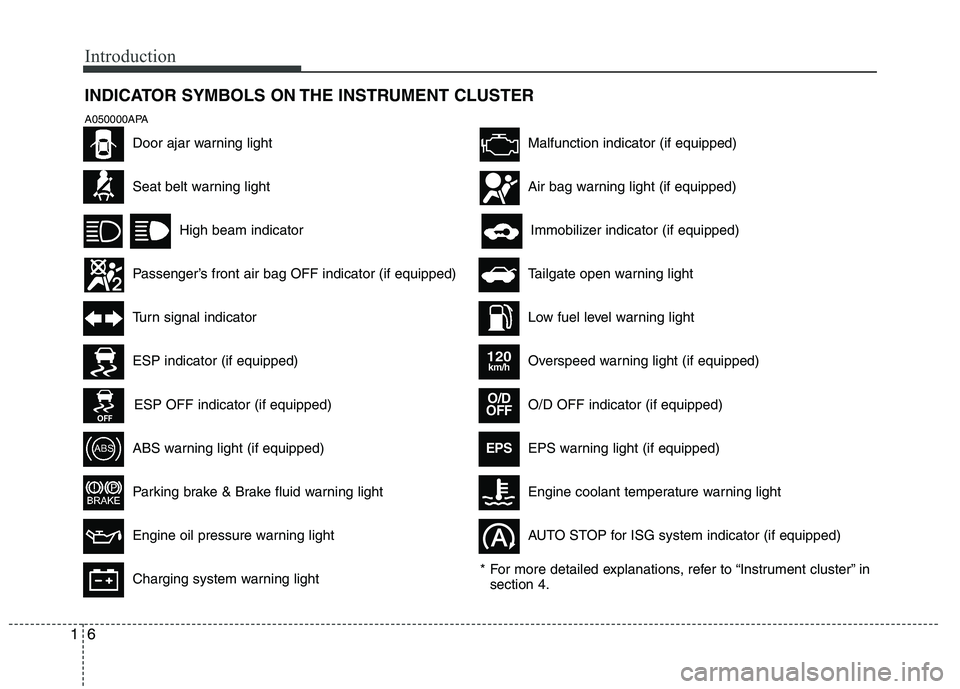
Introduction
6
1
INDICATOR SYMBOLS ON THE INSTRUMENT CLUSTER
Seat belt warning light
High beam indicator
Passenger’s front air bag OFF indicator (if equipped)
Turn signal indicator
ABS warning light (if equipped)
Parking brake & Brake fluid warning light
Engine oil pressure warning light
ESP indicator (if equipped)
ESP OFF indicator (if equipped)
Malfunction indicator (if equipped)
Air bag warning light (if equipped)
Immobilizer indicator (if equipped)
Low fuel level warning light
* For more detailed explanations, refer to “Instrument cluster” in section 4.
Charging system warning light
A050000APA
Door ajar warning light
Overspeed warning light (if equipped)
120km/h
Tailgate open warning light O/D OFF indicator (if equipped)
O/D
OFF
EPS warning light (if equipped) EPS
Engine coolant temperature warning light
AUTO STOP for ISG system indicator (if equipped)
Page 20 of 354
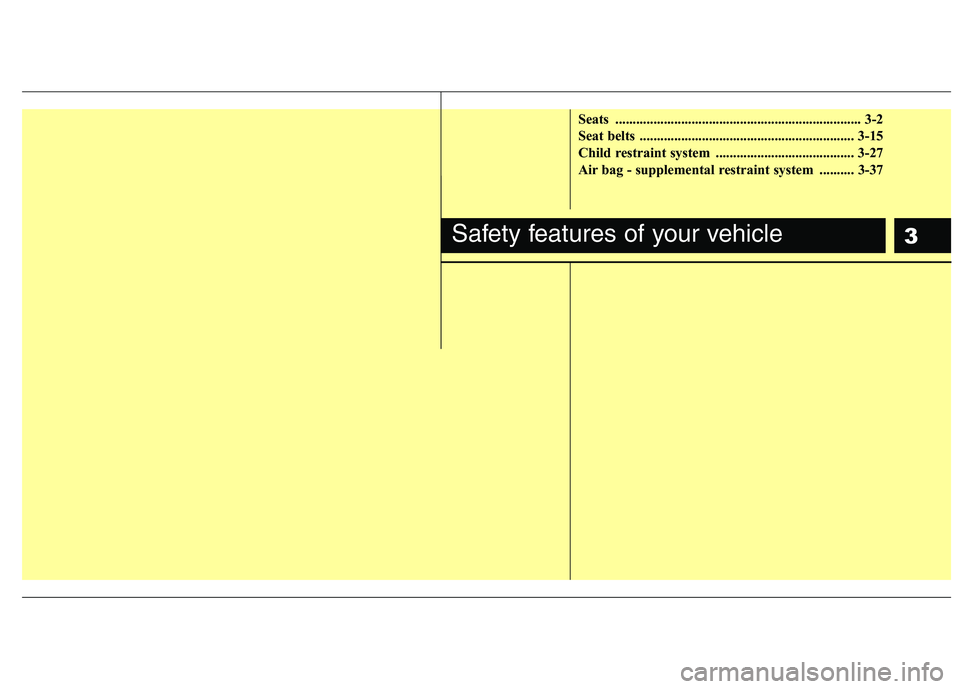
3
Seats ....................................................................... 3-2
Seat belts .............................................................. 3-15
Child restraint system ........................................ 3-27
Air bag - supplemental restraint system .......... 3-37
Safety features of your vehicle
Page 22 of 354
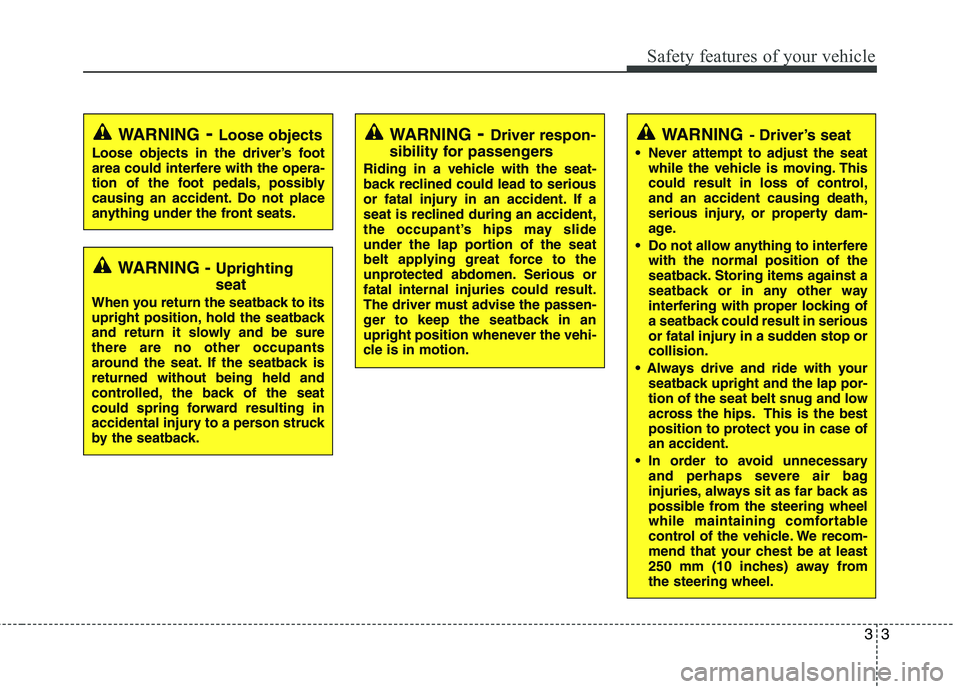
33
Safety features of your vehicle
WARNING- Driver’s seat
Never attempt to adjust the seat while the vehicle is moving. This
could result in loss of control,and an accident causing death,
serious injury, or property dam-
age.
Do not allow anything to interfere with the normal position of the
seatback. Storing items against a
seatback or in any other way
interfering with proper locking of
a seatback could result in serious
or fatal injury in a sudden stop orcollision.
seatback upright and the lap por-
tion of the seat belt snug and low
across the hips. This is the best
position to protect you in case ofan accident.
In order to avoid unnecessary and perhaps severe air bag
injuries, always sit as far back as
possible from the steering wheel
while maintaining comfortable
control of the vehicle. We recom-
mend that your chest be at least
250 mm (10 inches) away fromthe steering wheel.
WARNING - Uprighting seat
When you return the seatback to its
upright position, hold the seatback
and return it slowly and be surethere are no other occupants
around the seat. If the seatback isreturned without being held and
controlled, the back of the seat
could spring forward resulting in
accidental injury to a person struck
by the seatback.
WARNING - Loose objects
Loose objects in the driver’s foot
area could interfere with the opera-
tion of the foot pedals, possibly
causing an accident. Do not place
anything under the front seats.WARNING - Driver respon-
sibility for passengers
Riding in a vehicle with the seat-
back reclined could lead to serious
or fatal injury in an accident. If a
seat is reclined during an accident,
the occupant’s hips may slide
under the lap portion of the seat
belt applying great force to the
unprotected abdomen. Serious orfatal internal injuries could result.
The driver must advise the passen-
ger to keep the seatback in an
upright position whenever the vehi-
cle is in motion.
Page 29 of 354
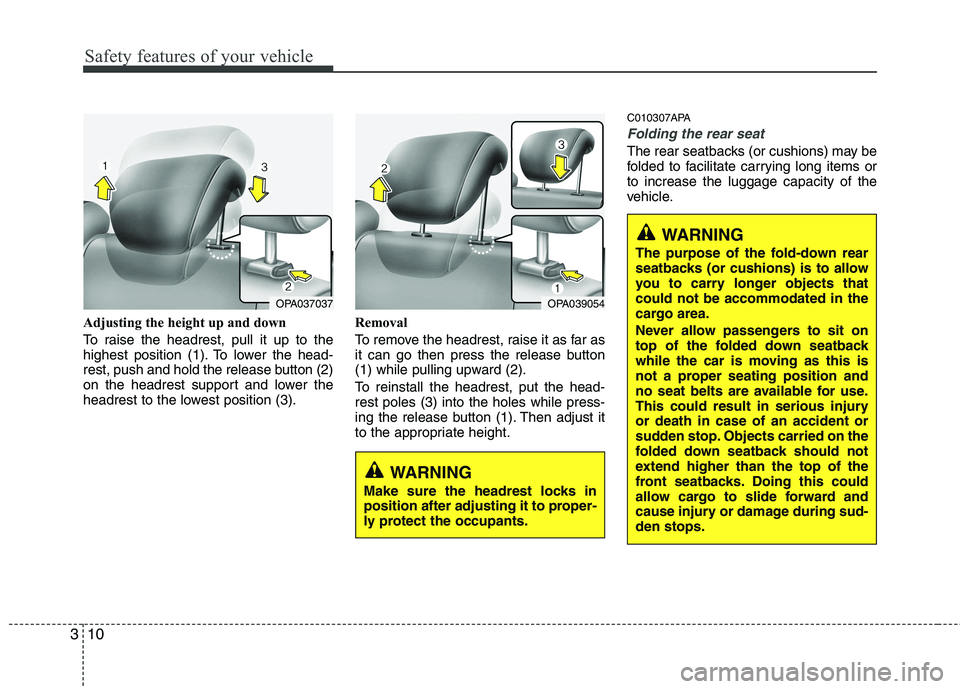
Safety features of your vehicle
10
3
Adjusting the height up and down
To raise the headrest, pull it up to the
highest position (1). To lower the head-
rest, push and hold the release button (2)
on the headrest support and lower the
headrest to the lowest position (3). Removal
To remove the headrest, raise it as far as
it can go then press the release button
(1) while pulling upward (2).
To reinstall the headrest, put the head- rest poles (3) into the holes while press-
ing the release button (1). Then adjust it
to the appropriate height.C010307APA
Folding the rear seat
The rear seatbacks (or cushions) may be
folded to facilitate carrying long items orto increase the luggage capacity of the
vehicle.
OPA037037
WARNING
The purpose of the fold-down rear
seatbacks (or cushions) is to allow
you to carry longer objects thatcould not be accommodated in the
cargo area.
Never allow passengers to sit on
top of the folded down seatback
while the car is moving as this is
not a proper seating position and
no seat belts are available for use.
This could result in serious injuryor death in case of an accident or
sudden stop. Objects carried on the
folded down seatback should not
extend higher than the top of the
front seatbacks. Doing this could
allow cargo to slide forward and
cause injury or damage during sud-den stops.
OPA039054
WARNING
Make sure the headrest locks in
position after adjusting it to proper-
ly protect the occupants.
Page 30 of 354
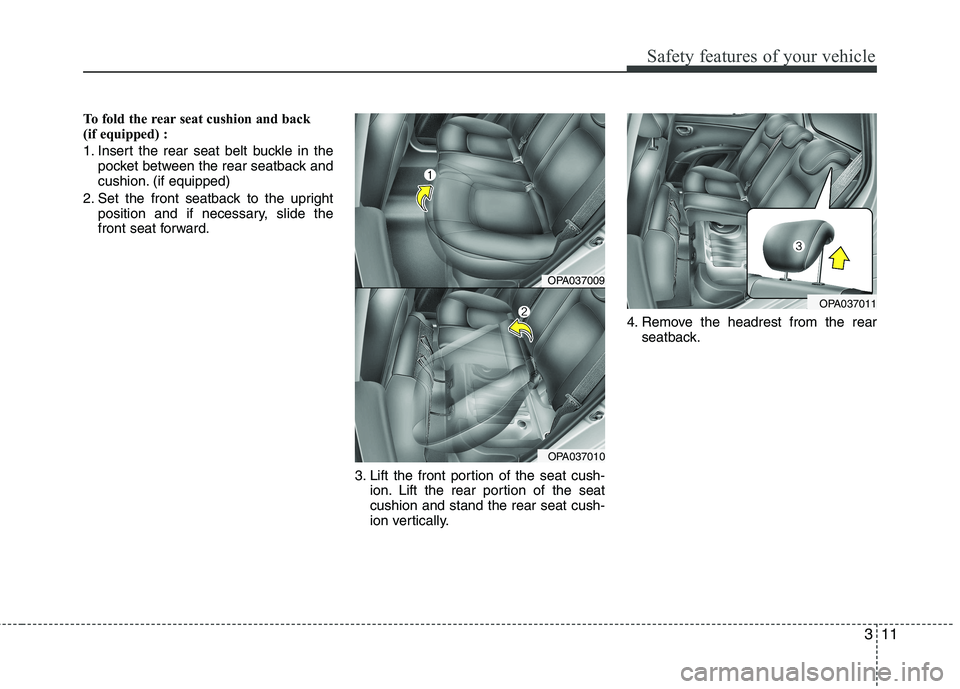
311
Safety features of your vehicle
To fold the rear seat cushion and back
(if equipped) :
1. Insert the rear seat belt buckle in thepocket between the rear seatback and
cushion. (if equipped)
2. Set the front seatback to the upright position and if necessary, slide the
front seat forward.
3. Lift the front portion of the seat cush-ion. Lift the rear portion of the seatcushion and stand the rear seat cush-
ion vertically. 4. Remove the headrest from the rear
seatback.
OPA037009
OPA037010
OPA037011
Page 31 of 354
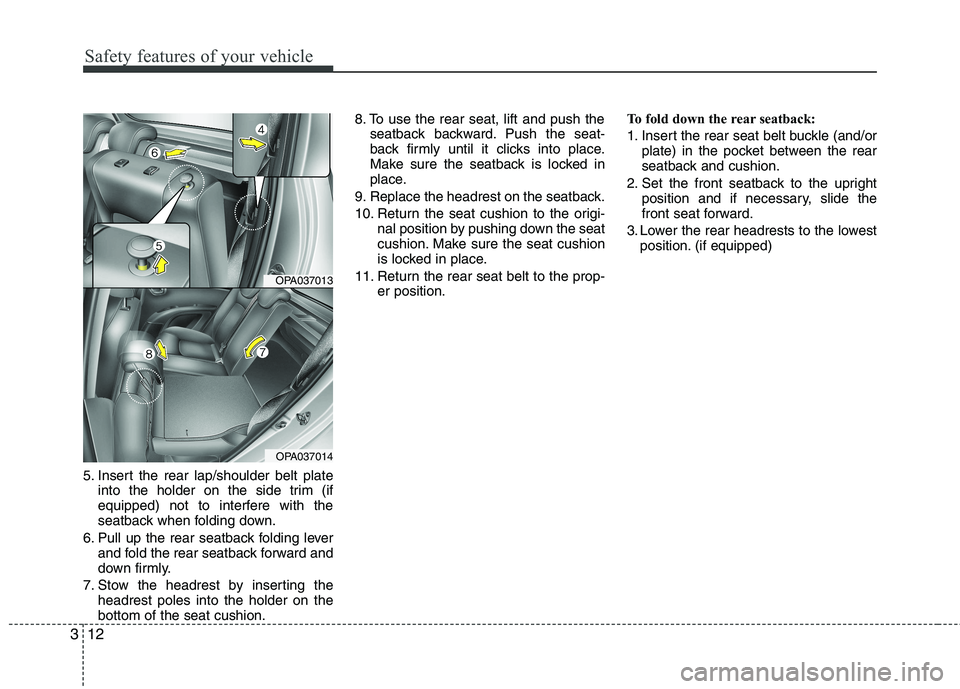
Safety features of your vehicle
12
3
5. Insert the rear lap/shoulder belt plate
into the holder on the side trim (if
equipped) not to interfere with the
seatback when folding down.
6. Pull up the rear seatback folding lever and fold the rear seatback forward and
down firmly.
7. Stow the headrest by inserting the headrest poles into the holder on thebottom of the seat cushion. 8. To use the rear seat, lift and push the
seatback backward. Push the seat-
back firmly until it clicks into place.
Make sure the seatback is locked in
place.
9. Replace the headrest on the seatback.
10. Return the seat cushion to the origi- nal position by pushing down the seat
cushion. Make sure the seat cushion
is locked in place.
11. Return the rear seat belt to the prop- er position. To fold down the rear seatback:
1. Insert the rear seat belt buckle (and/or
plate) in the pocket between the rear
seatback and cushion.
2. Set the front seatback to the upright position and if necessary, slide the
front seat forward.
3. Lower the rear headrests to the lowest position. (if equipped)
OPA037013
OPA037014
Page 32 of 354
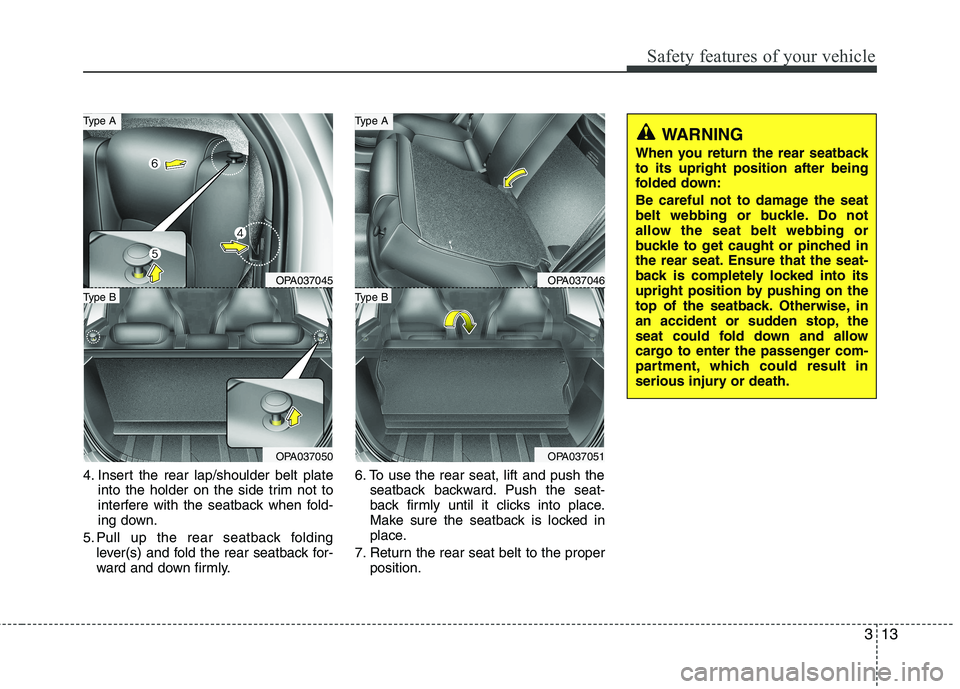
313
Safety features of your vehicle
4. Insert the rear lap/shoulder belt plateinto the holder on the side trim not to
interfere with the seatback when fold-
ing down.
5. Pull up the rear seatback folding lever(s) and fold the rear seatback for-
ward and down firmly. 6. To use the rear seat, lift and push the
seatback backward. Push the seat-
back firmly until it clicks into place.
Make sure the seatback is locked in
place.
7. Return the rear seat belt to the proper position.
OPA037045
OPA037050
Type B
Type A
OPA037046
OPA037051
Type B
Type A
WARNING
When you return the rear seatback to its upright position after being
folded down:
Be careful not to damage the seat
belt webbing or buckle. Do not
allow the seat belt webbing or
buckle to get caught or pinched in
the rear seat. Ensure that the seat-
back is completely locked into its
upright position by pushing on the
top of the seatback. Otherwise, in
an accident or sudden stop, the
seat could fold down and allow
cargo to enter the passenger com-
partment, which could result in
serious injury or death.
Page 33 of 354
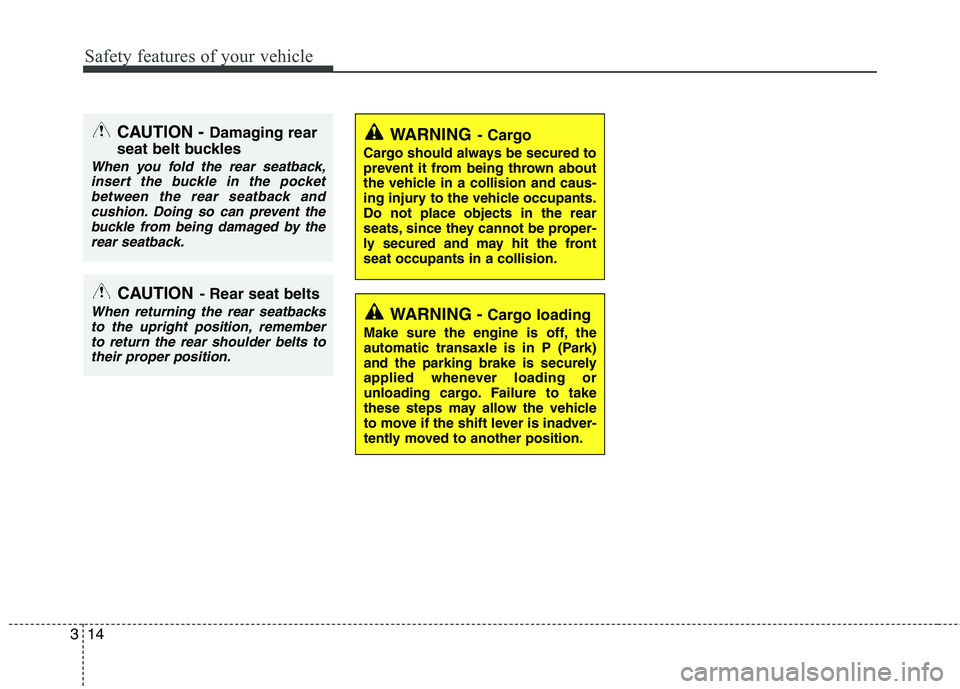
Safety features of your vehicle
14
3
CAUTION - Rear seat belts
When returning the rear seatbacks
to the upright position, remember
to return the rear shoulder belts totheir proper position.
CAUTION - Damaging rear
seat belt buckles
When you fold the rear seatback, insert the buckle in the pocket
between the rear seatback andcushion. Doing so can prevent thebuckle from being damaged by the rear seatback.
WARNING - Cargo loading
Make sure the engine is off, the
automatic transaxle is in P (Park)
and the parking brake is securely
applied whenever loading or
unloading cargo. Failure to take
these steps may allow the vehicle
to move if the shift lever is inadver-
tently moved to another position.
WARNING - Cargo
Cargo should always be secured to
prevent it from being thrown about
the vehicle in a collision and caus-
ing injury to the vehicle occupants.Do not place objects in the rear
seats, since they cannot be proper-
ly secured and may hit the frontseat occupants in a collision.
Page 34 of 354
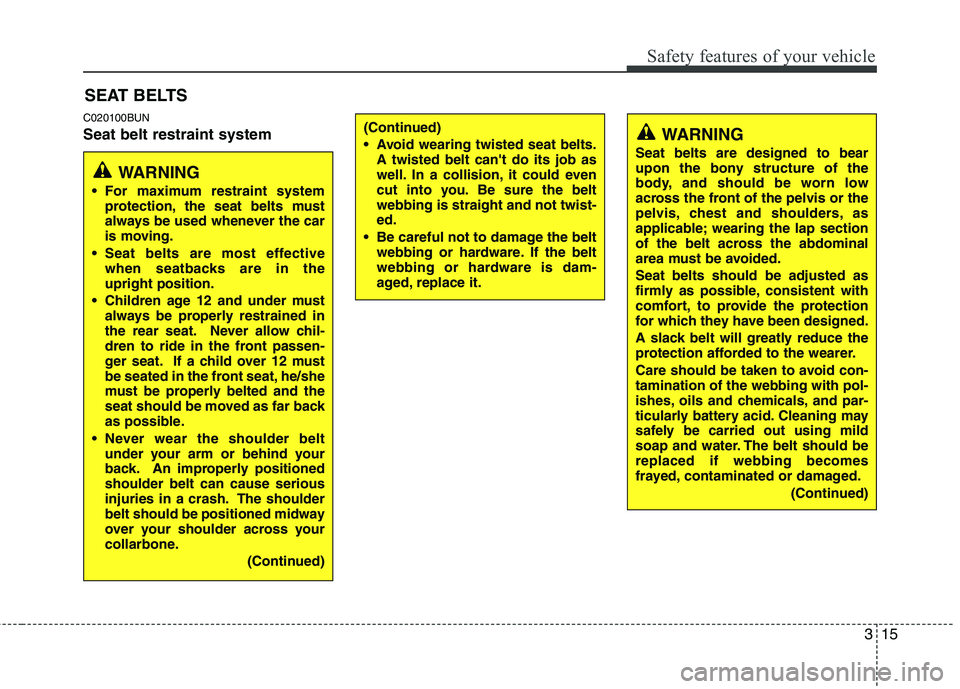
315
Safety features of your vehicle
C020100BUN Seat belt restraint systemSEAT BELTS
WARNING
For maximum restraint system protection, the seat belts must
always be used whenever the car
is moving.
Seat belts are most effective when seatbacks are in theupright position.
Children age 12 and under must always be properly restrained in
the rear seat. Never allow chil-
dren to ride in the front passen-
ger seat. If a child over 12 must
be seated in the front seat, he/she
must be properly belted and the
seat should be moved as far back
as possible.
Never wear the shoulder belt under your arm or behind your
back. An improperly positionedshoulder belt can cause serious
injuries in a crash. The shoulder
belt should be positioned midway
over your shoulder across your
collarbone.
(Continued)
WARNING
Seat belts are designed to bear
upon the bony structure of the
body, and should be worn low
across the front of the pelvis or the
pelvis, chest and shoulders, as
applicable; wearing the lap section
of the belt across the abdominal
area must be avoided. Seat belts should be adjusted as
firmly as possible, consistent with
comfort, to provide the protection
for which they have been designed.
A slack belt will greatly reduce the
protection afforded to the wearer.
Care should be taken to avoid con- tamination of the webbing with pol-
ishes, oils and chemicals, and par-
ticularly battery acid. Cleaning may
safely be carried out using mild
soap and water. The belt should bereplaced if webbing becomes
frayed, contaminated or damaged.
(Continued)(Continued)
Avoid wearing twisted seat belts.A twisted belt can't do its job as
well. In a collision, it could even
cut into you. Be sure the beltwebbing is straight and not twist-ed.
Be careful not to damage the belt webbing or hardware. If the belt
webbing or hardware is dam-
aged, replace it.
Page 35 of 354
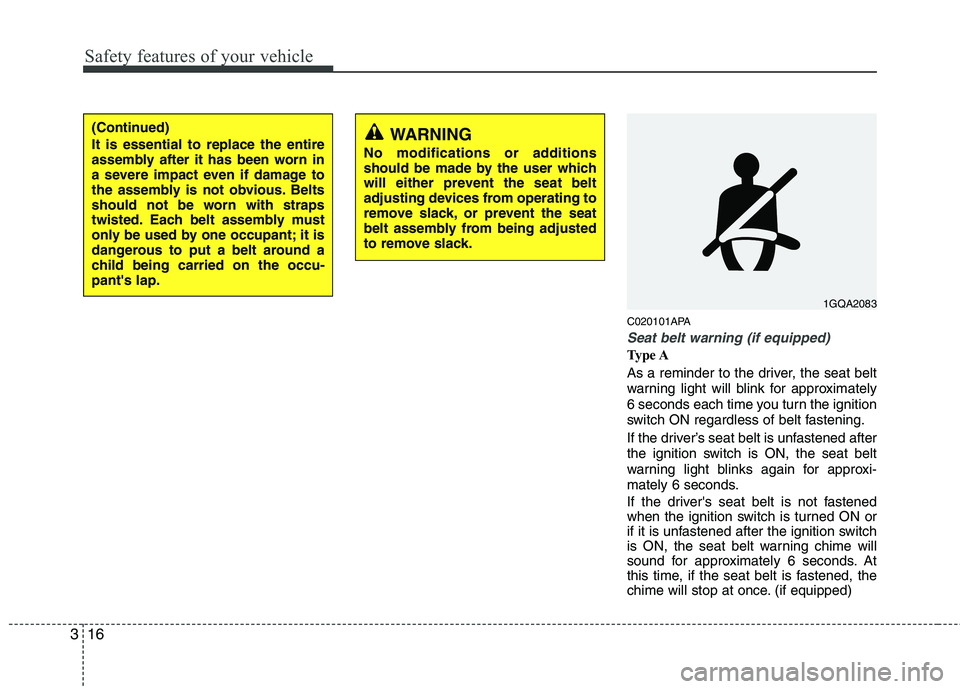
Safety features of your vehicle
16
3
C020101APA
Seat belt warning (if equipped)
Type A
As a reminder to the driver, the seat belt
warning light will blink for approximately
6 seconds each time you turn the ignition
switch ON regardless of belt fastening.
If the driver’s seat belt is unfastened after
the ignition switch is ON, the seat belt
warning light blinks again for approxi-
mately 6 seconds.
If the driver's seat belt is not fastened
when the ignition switch is turned ON or
if it is unfastened after the ignition switch
is ON, the seat belt warning chime will
sound for approximately 6 seconds. At
this time, if the seat belt is fastened, the
chime will stop at once. (if equipped)
1GQA2083
(Continued) It is essential to replace the entire
assembly after it has been worn in
a severe impact even if damage to
the assembly is not obvious. Belts
should not be worn with straps
twisted. Each belt assembly must
only be used by one occupant; it is
dangerous to put a belt around a
child being carried on the occu-pant's lap.WARNING
No modifications or additions
should be made by the user which
will either prevent the seat belt
adjusting devices from operating to
remove slack, or prevent the seat
belt assembly from being adjusted
to remove slack.